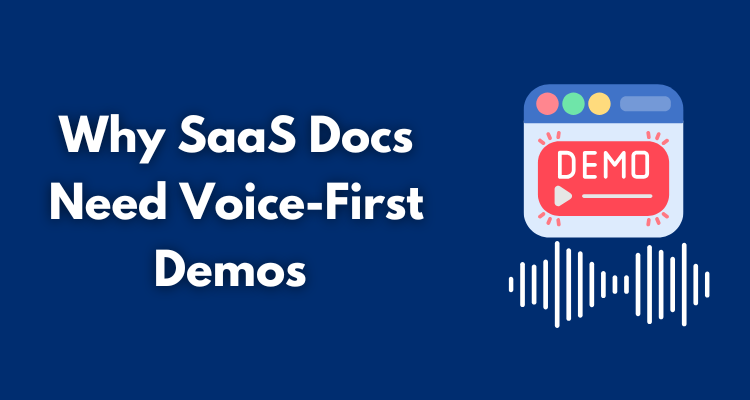It is 2025, and the Software as a Service (SaaS) landscape is changing at a rate never seen before. With user experience ruling the world today, canned, text-based documentation and generic video tutorials are not enough.
Users want immediate, intuitive, and customized access to information. This urgent need is paving the way for a new trend in SaaS documentation: voice-first demos.
If your SaaS platform is not at least exploring adding voice-activated demoing and taking advantage of improvements to AI voice generation, you’re already behind.
Table of Contents
ToggleThe Changing SaaS Landscape and User Experience
Today’s SaaS users are used to talking to technology. From smart home devices to voice-enabled assistants on their phones, spoken language is now a default way of interacting. It has increased expectations for all digital interfaces, including business software.
They no longer wish to navigate through multiple menus or read long handbooks to learn about a feature; they wish to query and receive an instant, relevant response or be led through a process without lifting a finger.
The need for more efficiency and accessibility also drives the demand. Experts are multitasking all the time, and having the possibility to discover a new feature in software or solve a problem while performing other tasks at the same time is a huge advantage.
Voice-first interaction is exactly what this need calls for: a smooth, natural way of interacting with sophisticated applications.

What are Voice-First Demos?
Voice-first demos are interactive software demonstrations in which the user interacts mainly through voice commands instead of clicks, scrolls, or keystrokes. Imagine them as an on-demand, personalized tutor built right into your SaaS product or its documentation.
Rather than seeing a pre-recorded video or following a step-by-step tutorial, a user can simply type out, “How do I build a new report?” and the demo will not only speak up but also visually walk them through the exact steps in the interface.
This spoken portion is typically based on sophisticated AI voice generation, taking advantage of the best text to speech software like Murf AI to provide natural-sounding and clear spoken instructions.
This is a big step from the linear and static product demo videos of old. While traditional voice-overs in video have been effective at improving clarity and engagement by breaking down complicated subjects, voice-first demos advance this with a dynamic, two-way conversation.
Significant Advantages of Incorporating Voice-First Demos within SaaS Documentation
The adoption of voice-first demos in SaaS documentation brings a multitude of benefits for both users and providers:
- Increased User Experience and Accessibility: Voice User Interfaces (VUIs) increase software accessibility to more users, such as those who are visually impaired or have mobility challenges. By allowing hands-free use and natural language understanding, VUIs make tasks easier and present a more intuitive and accessible interaction model.Users are able to navigate, learn, and solve problems without ever laying hands on a keyboard or mouse, resulting in an easier and more enjoyable experience.
- Improved Productivity and Efficiency: Voice interactions tend to be quicker than typing or maneuvering through menus. Consumers are able to rapidly execute tasks, search for answers, and get instant advice. This improves workflows, decreases the amount of time spent on repetitive activities, and enables consumers to multitask better.For instance, instead of having to browse through a knowledge base, the user might simply query, “What are typical problems with XYZ integration?” and be given a short, verbal response right within the demo environment.
- Personalization and Contextual Navigation: Progressive voice-first demos use AI to interpret intent and deliver extremely personalized experiences. They can learn user speech patterns, preferences, and even context within the application. This implies the demo can anticipate suggesting actions or navigating users through features most apt for their immediate workflow or expressed requirements, making the learning experience much more efficient and customized.
- Better Engagement and Retention: Interactive experiences cause better engagement. When users are able to actively engage in a demo by verbally issuing commands and getting feedback immediately, they are less likely to lose concentration and forget things. The active learning experience assists users in understanding advanced features faster and better, ultimately resulting in better product adoption and lower churn rates. Demos aren’t only for leads; they are an integral part of customer success and continuing user education.
Overcoming Challenges and Future Prospects
Although the advantages are self-evident, having voice-first demos is not without challenges, including maintaining high model accuracy in the presence of background noise and varying accents and handling privacy issues surrounding voice data.
But with continuing developments in Speech AI, these challenges are being overcome quickly and making the technology ever more powerful and reliable.
Forward to 2025 and beyond, voice-first demos are destined to be an integral part of SaaS documentation. They symbolize a paradigm shift toward more intuitive, effective, and user-centered learning processes.
Conclusion
In a competitive SaaS market, delivering outstanding documentation and learning experiences is essential to user adoption and retention. Voice-first demos, driven by advanced AI, present a unique chance to excel in both these aspects.
Adopting this technology, SaaS businesses can revolutionize their documentation as static assets and turn them into dynamic interactive learning buddies that enable users to streamline efficiency and actually set their products apart in the modern digital world.
The future of SaaS documentation is not only interactive; it’s conversational.









